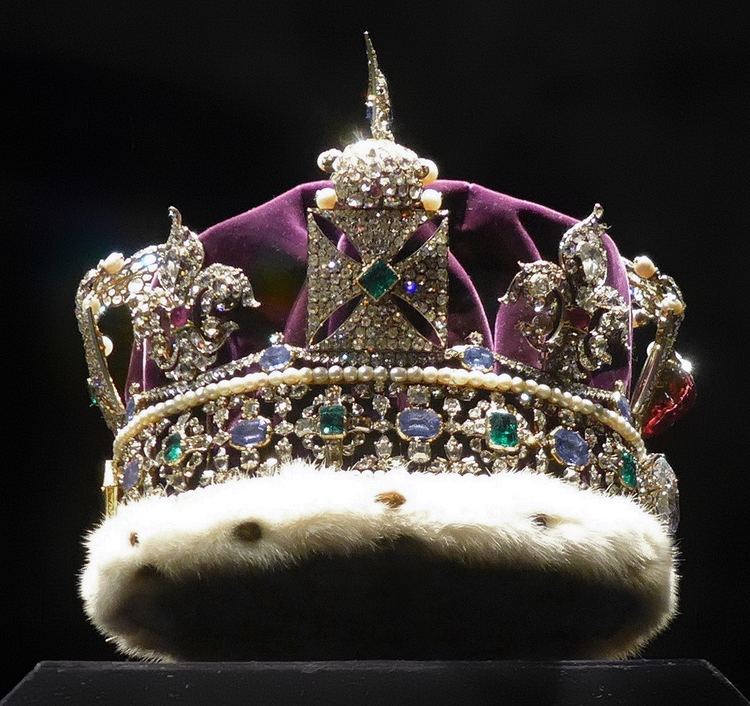Country United Kingdom Weight 1.06 kg (2.3 lb) Material Gold, silver, platinum | Made 1937 (current version) Arches Two | |
 | ||
Owner Queen Elizabeth II in right of the Crown | ||
The Imperial State Crown is one of the Crown Jewels of the United Kingdom and symbolises the sovereignty of the monarch. It has existed in various forms since the 15th century. The current version was made in 1937 and is worn by the monarch after a coronation ceremony (St Edward's Crown having been used to crown the monarch) and during his or her speech at the annual State Opening of Parliament. It contains 2,901 precious stones, including Cullinan II – the second-largest clear cut diamond in the world.
Contents
History
St Edward's Crown, used to crown English monarchs, was considered to be a holy relic, kept in the saint's shrine at Westminster Abbey and therefore not worn by monarchs at any other time. Instead, a "great crown" with crosses and fleurs-de-lis, but without arches (an open crown), was a king's usual headgear at state occasions until the time of Henry V, who is depicted wearing an imperial crown of state with gold arches (a closed crown). Arches were a symbol of sovereignty, and by this point in history, the king of England was being celebrated as rex in regno suo est imperator – an emperor of his own domain – owing obedience to no one but God, unlike some continental rulers, who owed fealty to more powerful kings or the Holy Roman Emperor.
Henry VII or his son and successor Henry VIII may have commissioned a more elaborate version of the state crown which is first described in detail in an inventory of royal jewels in 1521, and again in 1532, 1550, 1574 and 1597, and was included in a painting by Daniel Mytens of Charles I in 1631. The Tudor Crown had more pearls and jewels than its medieval predecessor, and the centre petals of each of the fleurs-de-lis had images of Christ, the Virgin Mary and St George. The crown weighed 3.3 kg (7 lb 6 oz) and was set with 168 pearls, 58 rubies, 28 diamonds, 19 sapphires and 2 emeralds. Following the abolition of the monarchy and the execution of Charles I in 1649, the Tudor Crown was broken up and its valuable components sold for £1,100.
Upon the restoration of the monarchy in 1660, a new state crown was made for Charles II by Sir Robert Vyner. About 10 versions of the crown have existed since the restoration. The one made for Queen Victoria in 1838 is the basis for today's crown. At the State Opening of Parliament in 1845, the Duke of Argyll was carrying the crown before Queen Victoria when it fell off the cushion and broke. Victoria wrote in her diary, "it was all crushed and squashed like a pudding that had sat down".
The gems in the crown were remounted for the coronation of George VI in 1937 by Garrard & Co,. The crown was adjusted for Queen Elizabeth II's coronation in 1953, with the head size reduced and the arches lowered by 25 mm (1 inch) to give it a more feminine appearance.
Description
The Imperial State Crown is 31.5 cm (12.4 in) tall and weighs 1.06 kg (2.3 lb), and has four fleurs-de-lis and four crosses pattée, supporting two arches topped by a monde and cross pattée. Its purple velvet cap is trimmed with ermine. The frame is made of gold, silver and platinum, and decorated with 2,868 diamonds, 273 pearls, 17 sapphires, 11 emeralds, and 5 rubies.
Notable stones are St Edward's Sapphire on the top cross, reputedly taken from the ring of Edward the Confessor when he was re-interred at Westminster Abbey in 1163, and the Black Prince's Ruby (a large spinel) on the front cross. In 1909, the 104-carat (21 g) Stuart Sapphire, set in the front of the crown, was moved to the back and replaced by the 317-carat (63 g) Cullinan II – the second-largest clear cut diamond in the world. Three of the pearls belonged to Elizabeth I.
Usage
The crown is worn by the monarch on leaving Westminster Abbey at the end of his or her coronation ceremony. It is also worn at the annual State Opening of Parliament. Usually, the crown is taken to the Palace of Westminster under armed guard in its own carriage and placed in the Robing Room, where Queen Elizabeth II dons her robes and puts on the crown before giving her speech to Parliament. When not in use, it is on public display with the rest of the Crown Jewels in the Jewel House at the Tower of London.
